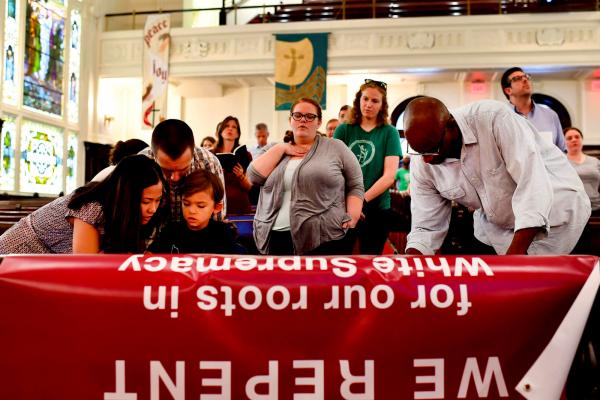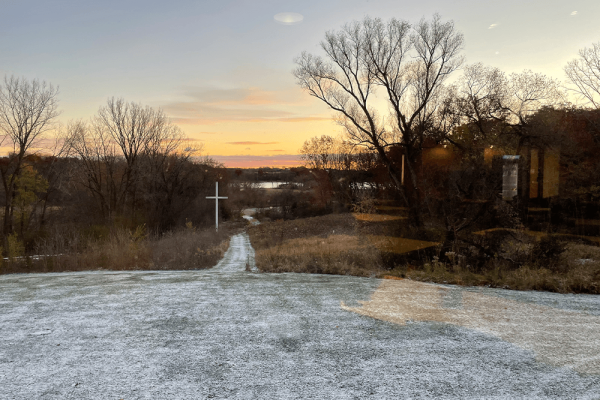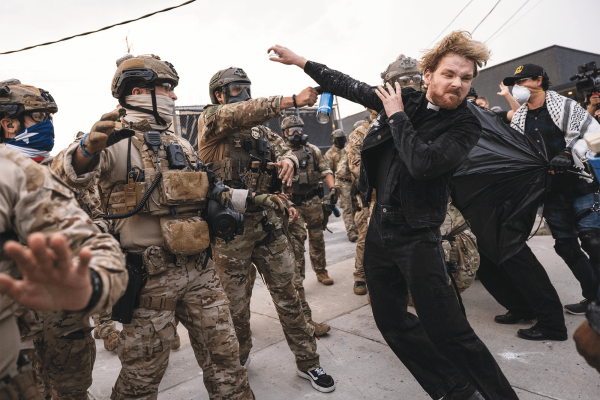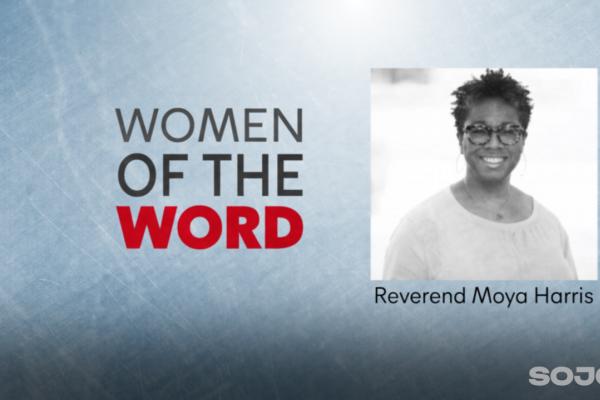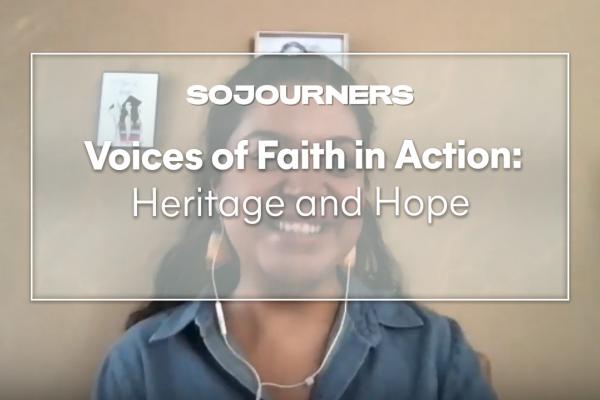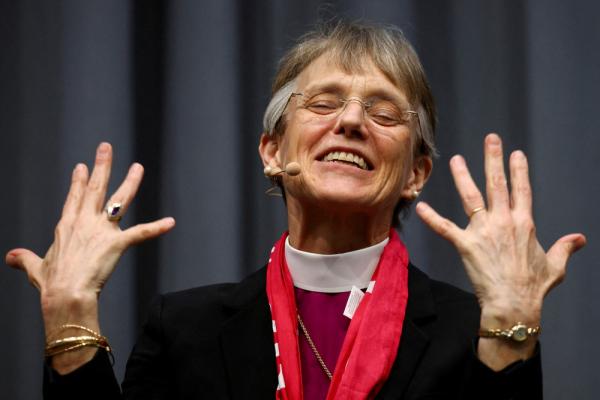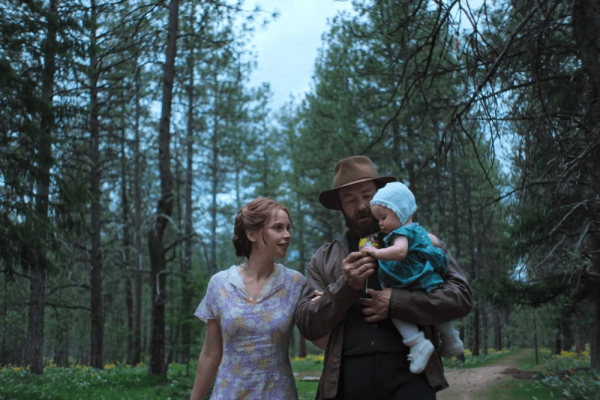FOR A GOOD SIX MONTHS, I didn’t notice the words carved above the grand sanctuary entrance to Mount Vernon Place United Methodist Church in Washington, D.C. The letters stand guard over the doors like sentries: Methodist Episcopal Church, South. The words meant nothing to me.
In February, the General Conference of the UMC voted to strengthen the enforcement of denomination rules against ordaining LGBTQ Christians and performing marriage ceremonies for LGBTQ couples. But Mount Vernon Place (MVP) has long described itself as “young and old, gay and straight, liberal and conservative, housed and unhoused, people filled with faith and people who know doubt.” It struck me as a place I could fit in and be challenged.
On my first visit, I was intrigued by a bulletin notice announcing the launch of a racial-justice book group—especially since the congregation is predominantly white. So I joined.
Book group leader Caroline Anderson-Gray, white and in her 30s, has been a member at MVP for four years. I asked her why she started MVP’s racial justice conversation with a book group.
“In the summer of 2016, as reports of police officers killing black citizens seemed to be at the top of the news every other day, our minister raised the idea of a racial-justice reading group,” said Anderson-Gray. “I believe that to be Christian is to be committed to dismantling structures of hatred and inequality, so a reading group on the subject of racial justice at church made a lot of sense to me. By the time we had our first meeting, the presidential election had occurred, and the need for such a group was more urgent than ever.”
A book group may not seem like much given the rise of social terror. But small discipleship groups are a very Methodist practice—and this one opened a space for transformative conversations. Eight to 12 people, a microcosm of the church, gathered every other month to read and learn. One man, a Canadian expatriate, spoke about his difficulty in understanding his new country considering the experiences of his African-American husband. Una Song, an MVP member for three years, said that reading Patricia Raybon’s My First White Friend helped Song clarify her own experiences of exclusion in a country dominated by white privilege.
“Throughout my life, I’ve always felt like an ‘other,’ not accepted as being fully American even though I was born and bred here. I could relate to that feeling of not being fully accepted by whites,” Song said. “People would ask me where I’m from and they don’t want to hear California. They want to hear Korea, but that’s where my family is from. What they’re saying to me is you’re not from here.”
The group worked through books by Ta-Nehisi Coates, James Cone, and Michelle Alexander. The Holy Spirit and our denomination’s guidelines led our efforts: “We cannot just be observers. So, we ... call each of us into a response, no matter how controversial or complex.” We listened, learned, and challenged, until we could no longer just be observers.
That’s when I learned about the Methodist Episcopal Church, South.
The past is not past
The founder of Methodism, John Wesley, wrote “Thoughts on Slavery” in 1774, condemning slavery and proposing a boycott of slave-produced sugar and rum. When Methodists gathered for the first time in the United States six years later, they also condemned slavery as “contrary to the laws of God, man, and nature, and hurtful to society.”
But not every Methodist caught the abolitionist zeal. In 1844, the Methodist Episcopal Church, South splintered from the greater denomination so that its members—some 500,000 across the South—could defend slavery while remaining within the church. Between 1846 and 1861, every person elected as a bishop for the Methodist Episcopal Church, South was a slaveholder. The denomination remained separate for nearly 100 years, through Reconstruction and much of the Jim Crow era, only reuniting with two other branches of Methodism in 1939; this larger denomination then became part of the United Methodist Church in 1968.
Mount Vernon Place was founded in 1850 as a congregation of the Methodist Episcopal Church, South in the nation’s capital, a federal district that had been carved out of two slave states, Maryland and Virginia .
In October 1917, the MVP congregation laid the cornerstone for a grand, Georgian-style building in the heart of the nation’s capital. In the 1950s, church membership was in the thousands. By the end of the 1960s, that number had plummeted, especially following unrest in the city after the assassination of Martin Luther King Jr.
I found a curious disconnect between what was recorded by MVP’s historian in 1977 about the life of the congregation and what was happening across the city and country.
For instance, on slavery: “The Methodists were simply a part of the country and therefore a part of the division. All of the Southern states passed laws forbidding emancipation. The Southern Methodists took the position that, ‘We must obey the law.’”
And this: “Although Mount Vernon Place did not create the problems, the church had to deal with them. For instance, the Civil War of 1861-1865 brought our little church to its knees. A century later during the 1960s the changing contemporary society and the social order of our country created vexing conditions which were national in scope. Churches, including our own, faced social unrest of youth, civil rights, impact of urbanization and moves to suburbs, the Vietnam conflict, and skepticism of traditional religious values by both young people and adults. Our membership and church attendance declined. Youth activity dwindled. Members feared crime possibilities, especially at night time. Mount Vernon Place Church could not seem to find a corrective answer to its tribulations.”
These summations are framed in a way that seeks to absolve the congregation from societal injustices—as though the world beyond the sanctuary wasn’t made up of actual people, some of whom worshiped inside the sanctuary. For more than a century, those “vexing conditions” caused tribulations for many lives outside MVP’s grand sanctuary entrance.
Lamenting a history
In summer 2017, MVP members once again faced “vexing conditions” as white supremacists marched in Charlottesville, Va., to protest the removal of Confederate statues. One of those young white men murdered counterprotester Heather Heyer. This time, MVP chose to connect the past to the present.
In October that same year, Mount Vernon Place marked the centennial of laying the church’s cornerstone. During the Sunday morning service, MVP pastor Donna Claycomb Sokol led the congregation in a litany of remembrance and repentance: “We lament a history in which people valued property over people. We lament the ways in which this church contributed to the wounds of an entire nation. We lament the proclamation of white supremacy and the belief that such a proclamation is consistent with the gospel of Jesus Christ.”
Together, we publicly repented, echoing our baptismal vows: “We repent of every way in which we have failed to reject racism that denies the dignity of anyone, choosing to instead participate in, gain privilege from, or remain silent in the face of injustice in our judicial system, our educational system, and our economic system.”
Church members were invited to add a signature of their commitment on a large banner that would hang prominently on the church’s exterior: “We repent of our roots in white supremacy. Building a foundation of truth and reconciliation.”
Adults and children lined the aisle waiting to add their names. Johnnie Richardson, security concierge for the church, hung the banner outside after the service—and added his signature.
Six weeks later, the banner would be defaced for the first time.
Ongoing repentance
For Methodists, repentance is turning away from behaviors rooted in sin and toward actions that express God’s love. It’s also ongoing.
“Repentance is never one time,” said Claycomb Sokol. “It’s this constant evaluation and prayerful eyes-wide-open look at what’s happening in the wider world. Where do I see injustice and oppression and then how am I called to respond to that? In many ways, the easiest thing we did was to sign and hang the banner. But how do we keep holding up that message regardless of how many people want to pull it down?”
The most notable defacement of the banner was the first. In the night, someone covered the banner with several printed copies of “alternative” 10 commandments. The lines included: “Thou shalt not let The New York Times determine the Christian agenda. Thou shalt not embarrass white people with this kind of weak, historically ignorant bullshit. Thou shalt not enlist God in the political battles of this world.”
The church also received phone calls and emails thanking MVP for its public message. Pictures of the banner popped up on social media. Claycomb Sokol told our church’s story to a crowd at the Martin Luther King memorial on the 50th anniversary of King’s assassination.
A few people left the congregation over the following months. Some said they were caught off guard by the banner and what they called a politically charged tone they didn’t appreciate.
Meanwhile, 20 people—about 15 percent of MVP’s weekly attendance—signed up for a six-week study on racial justice. Then another group began meeting to discuss “Seeing White,” a podcast series about race and white privilege produced by Scene on Radio.
‘Cousin churches’
Through the book group, I’ve come to know Carol Travis, 72, who worked on the MVP staff for several years. Travis is a member of Asbury United Methodist Church, a predominantly African-American congregation two blocks from MVP. She’s also an avid reader. MVP’s book group lured her in, along with her understanding of the history and congregation at MVP.
“Knowing what I know about [Mount Vernon Place], I knew there would be few people of color in this book club,” said Travis. It was important to her for other members to hear from that perspective.
Asbury is another D.C. Methodist church with a complicated history. It was founded in 1836 by black members who had left Foundry Methodist Episcopal Church, where they had been treated as lesser congregants, forced to sit in the balcony for worship and denied opportunities for full inclusion.
In 2002, Foundry (now known as Foundry United Methodist Church) conducted a walk of repentance from its building to Asbury, where church leaders and members received them. A few weeks later, Asbury members walked to Foundry and bestowed forgiveness. Travis affectionately calls the two “cousin churches.”
MVP and Asbury might be called distant relations. Travis grew up in the Asbury congregation and walked past MVP each Sunday to attend her church, but she can’t remember any interactions between the two communities during her youth. “We did not go where we historically were not welcome,” she said, though she adds that Asbury nurtured her to such a degree that she had no need to seek out another community. In more recent years, MVP and Asbury have held joint worship services and shared outreach events. But a distance greater than two blocks remains.
As an African-American woman and lifelong D.C. resident, Travis recalls the tribulations of the 1960s referenced by the MVP historian. “The 1968 riots had a huge influence on this place. Whites were afraid to go into the city. For us blacks, Dr. King was our hero, and when he was gunned down, people didn’t know what to do with their anger and fear. They didn’t know anything else than to go after their own neighborhoods. It was a frightening time to be in the city. Black people were looting and burning up their own neighborhoods. People didn’t have the language to discuss race relations as they do now,” Travis said.
Do we have that language now? I’m not sure we white people do. I’m still learning it. I’m not sure churches have that language either. When conversations become too painful or uncomfortable or difficult, it is still easier to shut them down rather than hang in for the hard work. Travis agrees. “Race relations has always been the work of white folks, but white folks haven’t seen it that way,” she said.
Repentance, thankfully, provides an avenue to keep working at it. Mount Vernon Place’s journey has prompted my own—exploring white supremacy and racism in my own family, starting with Moses Henegar, my great-great grandfather, Confederate soldier in the Alabama 6th infantry, and Baptist preacher. He’s mine to claim, take responsibility for, and turn from.
Poet Nikki Giovanni said, “If now isn’t a good time for the truth I don’t see when we’ll get to it.” In the body of Christ, we can repent, take up our responsibilities together, and allow the truth to set us free.
Starting the Conversation
The reading list for the Mount Vernon Place UMC racial-justice book group:
- My First White Friend, by Patricia Raybon
- Between the World and Me, by Ta-Nehisi Coates
- The Cross and the Lynching Tree, by James Cone
- The Blood of Emmett Till, by Timothy Tyson
- Evicted, by Matthew Desmond
- I’ve Got the Light of Freedom, by Charles M. Payne
- Tears We Cannot Stop, by Michael Eric Dyson
- The New Jim Crow, by Michelle Alexander
- Reconstructing the Gospel, by Jonathan Wilson-Hartgrove
- The Color of Law, by Richard Rothstein
- The Hate U Give, by Angie Thomas
- White Fragility, by Robin DiAngelo
- Heavy: An American Memoir, by Kiese Laymon

Got something to say about what you're reading? We value your feedback!
